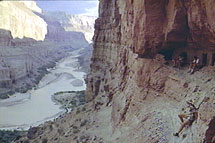|
|
|
|
|
|
|
|
|
|
|
|
|
|
|
|
 For
Teachers For
Teachers
|
|
|

|
|
Experience
the Grand Canyon in the January 2006
National Geographic magazine
article, "The Unexpected
Canyon." Then bring it to your
students with our Classroom
Companion.
|
|
|
|
|
|
Make
your way around the
South Rim and uncover
canyon life and history.
Plus, visit Kids Canyon
to get your students
down into Earth's
history, and check out
our canyon lesson plans
and creature features.
|
|
The
United States has more
than 600 million acres
(240 million hectares)
of public lands, which
belong to all Americans.
In this lesson, students
will explore
little-known tales of
these protected places.
|
|
In
this lesson students
will analyze the roles
of climate and other
natural forcessuch as
tectonics, weather, and
glaciationin shaping
places.
|
|
|
|
GeoKits:
Get Videos, Transparencies, and
More in Our Complete Curriculum
Modules
GeoSpy:
Fast-Paced Place-Name Game
|
|
|
|
Join
National Geographic's
free online EdNet
for exclusive materials
and opportunities:
Collaborative work
spaces
Discussion boards
Workshops and
conferences
Much more
Preview
EdNet today >>
|
|
|
|
|
Home
| Site
Index | Search
| Free
Newsletters | Subscriptions
Contact Us
| Advertise With Us
| Privacy Policy
| Press Room
 National Geographic
Society
National Geographic
Society
NATIONAL
GEOGRAPHIC - THE BIRTH OF A SOCIETY
On the evening of January 13, 1888, thirty-three men traveled on
foot, horseback, and in horse drawn carriages through the streets
of Washington to the Cosmos Club, then on Lafayette Square
across from the White House. They convened around a large
mahogany table to discuss the advisability of organizing a
society for the increase and diffusion of geographical
knowledge. The entity they were about to create would become
the largest nonprofit scientific and educational institution in
the world.
EXPEDITIONS
ONLINE:

The
ultimate Robot Boat. Solarnavigator uses an advanced SWASSH
hull as the platform to mount the world's first autonomous
circumnavigation. A successful expedition could pave the way for
improved safety
at sea.
|


